NVIDIA's GeForce GTX 550 Ti: Coming Up Short At $150
by Ryan Smith on March 15, 2011 9:00 AM ESTPower, Temperature, & Noise
Last but not least as always is our look at the power consumption, temperatures, and acoustics of the GTX 550 Ti. As a result NVIDIA’s tinkering with both power efficiency and clocks, performance has gone way up but power has also gone up too: the official TDP has gone up by 10W.
Please note that as we don’t have a true reference card our testing methodology has been slightly tweaked. We’ve tested the AMP at both GTX 550 Ti reference clocks and at its factory overclock for all metrics, however noise and temperature in particular are going to significantly vary from manufacturer to manufacturer.
| GeForce GTS 450 & GTX 550 Voltage | ||||
| GTS 450 | Zotac GTX 550 Ti Amp | Idle | ||
| 1.05v | 1.1525v | 0.95v | ||
The load voltage on our Zotac AMP is 1.1525v, which compared to GF106/GTS 450 ends up being quite high. No doubt Zotac has given the card some more voltage to handle the factory overclock, however this will also skew our power results for load. Idle however remains unchanged at 0.95v.
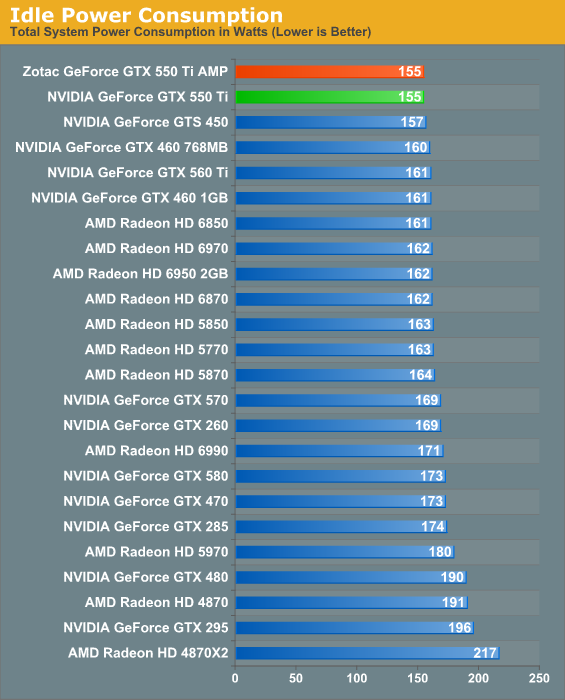
Right off the bat, idle power consumption looks good. At 155W the Zotac GTX 550 AMP beats even the reference GTS 450 by 2W, and the gap with the Radeons is much larger. Here we’re looking at a 6W advantage over the 6850, and 8W over the 5770. This is no small feat given how hard it is to reduce idle power usage, and showcases the benefits of NVIDIA’s transistor tinkering.
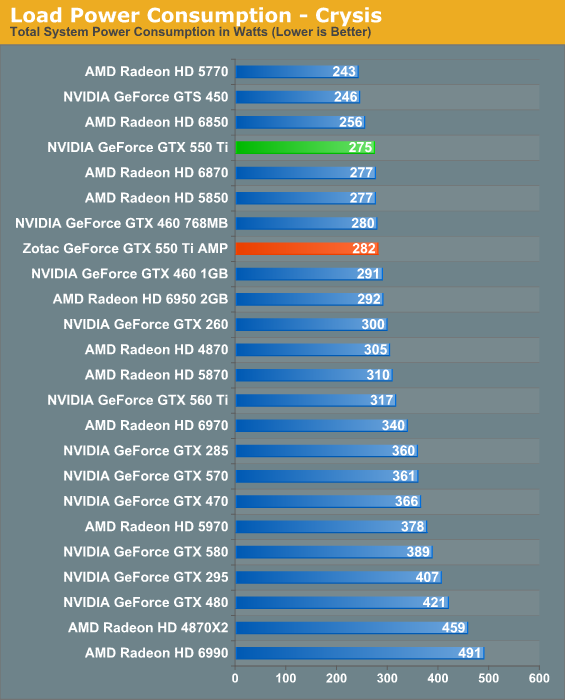
Power consumption leaves much to be desired however, and it’s at this point that we can’t easily separate the GTX 550 Ti from the Zotac GTX 550 AMP. If the Zotac card did not have an overclock, perhaps it would have a lower load voltage, and as such lower power draw under load. But in this case it does not, which leads to a total system power draw difference of 19W over the 6850, never mind the 5770.
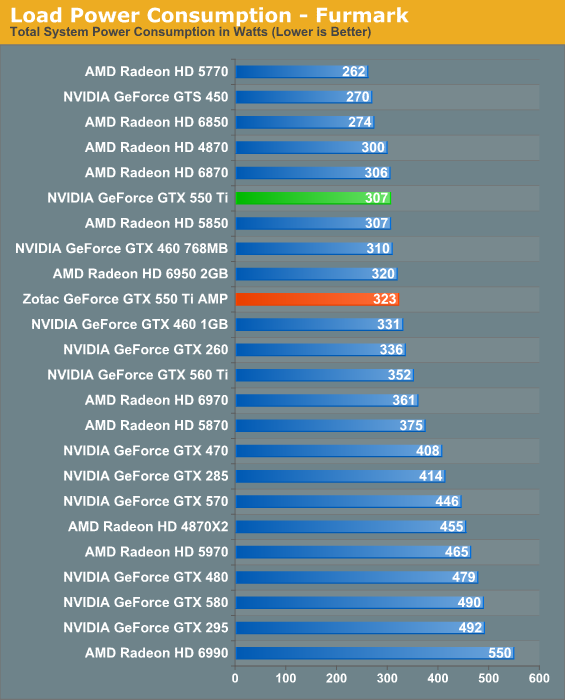
The GTX 550 Ti does not have any kind of overcurrent protection like the rest of the GTX 500 series, so here we can get straight numbers without forcibly disabling it. The results, like with Crysis, are understandably poor for the card; 33W over the 6850, more for the card when it’s running at factory clocks. If a more reference style GTX 550 Ti is anything like this, it bodes poorly for the card compared to the already faster 6850.
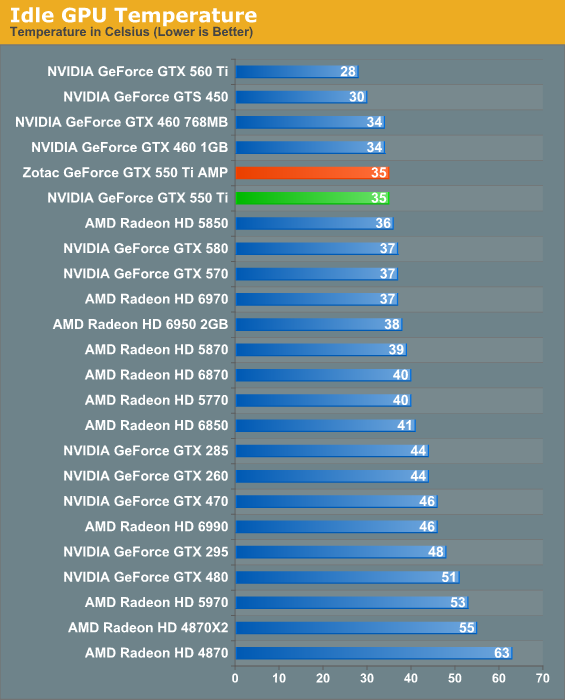
The king of our idle temperature charts is composed of NVIDIA reference cards, and while the Zotac GTX 550 AMP gives a decent performance, it can’t keep up. 35C at idle is still quite good, but we saw better on the GTS 450, and would likely see something similar on a reference GTX 550 Ti.
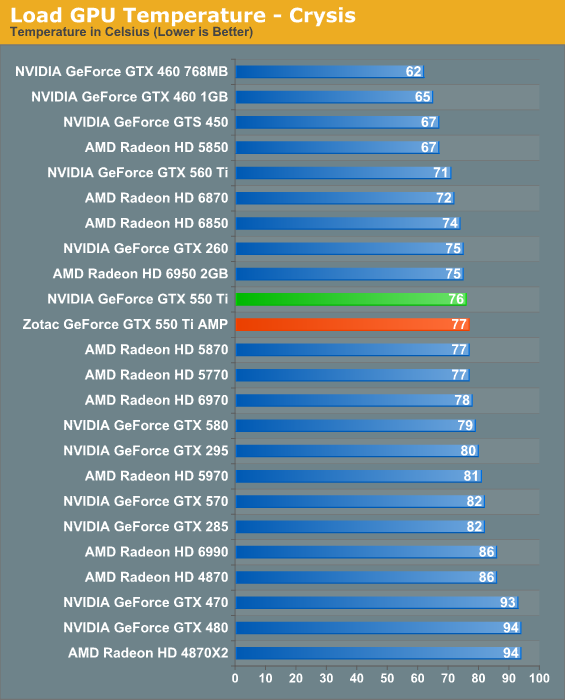
Under load, temperatures end up being middle the road, thanks once more to the card’s higher power consumption. Funny enough it does beat the 5770 by 1C even after all of this, but one could just as well slap the GTX 460 cooler on here and get results that would undoubtedly be below 70C.
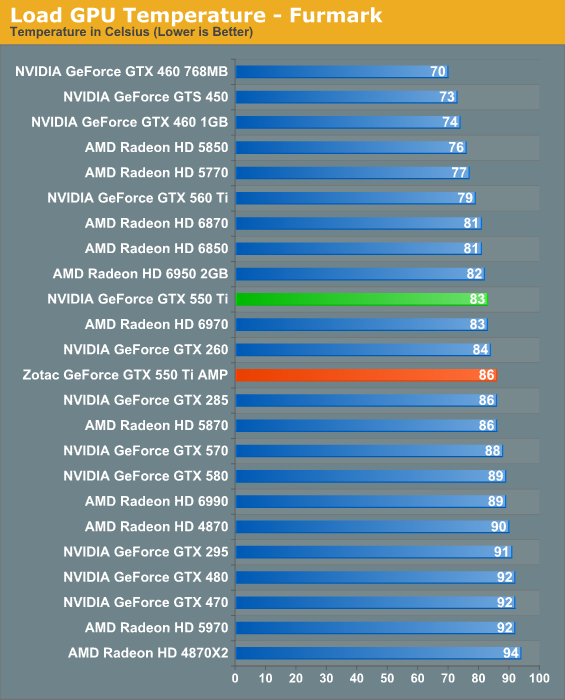
FurMark of course adds several C more to our temperatures. In fact for a lower power card like the Zotac GTX 550 AMP we’re actually caught a bit off-guard. 86C at factory clocks means there’s some thermal headroom to play with for overclocking, but not too much – the GTX 550 Ti’s max temperature is only 95C.
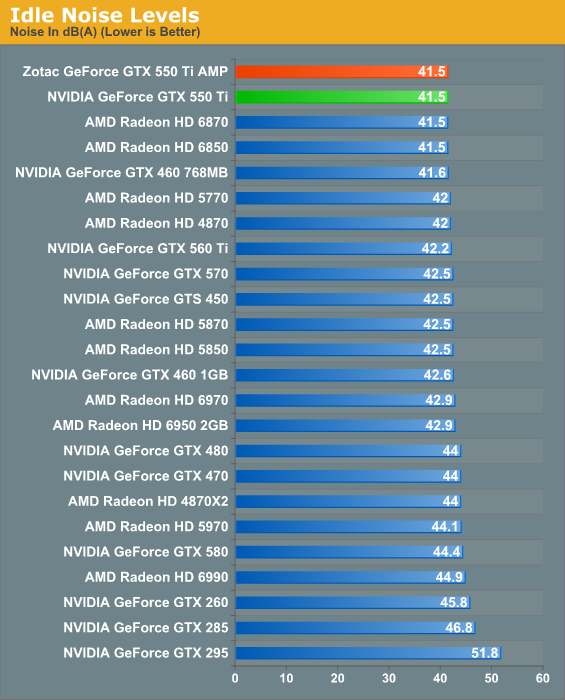
For cards in this performance category, idle noise is pretty consistent thanks to the common use of open coolers. The Zotac GTX 550 AMP doesn’t disappoint here, offering a practically silent 41.5dbA as measured by our meter.
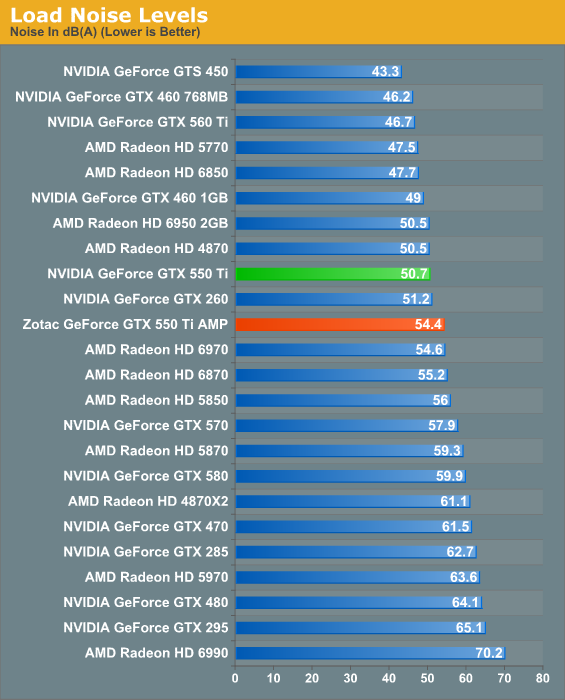
If you were hoping that higher temperatures would be a precursor to lower fan noise, you’re going to come up empty handed here. 50.7 is by no means loud among all the cards we’ve tested, but we’ve seen better. In fact the 5770/6850 both do better, as does the GTX 460 and GTX 560. At the AMP’s full factory overclock we get up to 54.4dbA, which is certainly going to be noticeable. Unfortunately the card doesn’t have the performance even with the overclock to justify the noise.
Ultimately this is less a discussion of the GTX 550 Ti reference design, and more a discussion on the Zotac GTX 550 Ti AMP’s design, which more likely than not takes a hit in cooling and temperatures thanks to the 2nd DVI port partially blocking the card’s external exhaust. But for the time being, it’s what we have to work with.










79 Comments
View All Comments
HangFire - Tuesday, March 15, 2011 - link
Advertisers hate it when you see how competitive older offerings are with new stuff. So, little-used features like in DirectX 11 are used to force out comparisons with older cards that still deliver great frame rates and value, and cause users to not upgrade for a while.We won this battle for a while and AT had a few older cards it included in its benchmarks. Now its back to nothing but the latest.
morphologia - Tuesday, March 15, 2011 - link
"Nothing but the latest?" The 4870 and 4870X2 shown in this comparison are hardly current. I suppose the 4870 is less likely to outperform than the 4890 is, but the X2 makes an even stronger showing. Still does not make sense.Also, on an unrelated note, it looked like the 6990 was dropping out of various comparison scales without explanation. BattleForge 1680x1050, for example. 6990 dominated the 1920x1200 but was inexplicably absent from 1680x1050, instead the 580 topped that chart. What's up with that??
Ryan Smith - Tuesday, March 15, 2011 - link
The 6990 is not on any of the 1680 benchmarks. It's already CPU limited at 1920; at 1680 it's useless data since no one is going to use it at that resolution.Ryan Smith - Tuesday, March 15, 2011 - link
Due to the amount of time it takes to benchmark (and rebenchmark) GPUs, it's necessary to keep a truncated list, and from there not every card actually makes it in to the article (and this is why we have GPU Bench). As such I focus on the current and previous generation of GPUs, while throwing in a sampling of 3rd & 4th generation GPUs as a baseline.I specifically pick these older GPUs based on architecture and relative performance - the idea being that while we don't have every GPU in the system, if it's a few years old it's well established how other minor variations of that GPU perform relative to the one in our results database. So in this case the 4870 is in there both because it's easy to visualize where the 4850/4890 would be relative to it, and because it was easily the most popular 4800 card.
morphologia - Tuesday, March 15, 2011 - link
Seems like the 4870X2 was a bit of a spoiler, seeing as how it trumped a few of even the current generation, though it too was dropping in and out of the bar charts with no explanation. If you are going to include it at all, there should be more consistency. Otherwise it looks like ranking/stat doctoring.7Enigma - Thursday, March 17, 2011 - link
Ryan's already mentioned why. It's a dual GPU card at the time was likely not tested at the low resolutions this particular article used for these lower-end cards. Likely 1920X1200 (or 1080) was the lowest this card was benchmarked at. I applaud Anandtech for including the data they have, and as mentioned you can use Bench to compare to your hearts desire. Bottom line: it is unlikely someone is gaming at less than 24" resolutions with a 4870X2, and if they are they can use Bench for that particular purpose.These guys have enough to do without going back and retesting cards from years ago. I'm just glad the data is in there.
nwarawa - Tuesday, March 15, 2011 - link
I didn't hear much complaining about the GTX460 768MB all this time : all the reviews were heralding its value. Now we have an even less powerful GPU, and 768MB suddenly becomes an issue? The heck with that. 768MB should be the standard configuration for this card, with a MSRP of $129. If you want high resolutions with AA, you should be getting a more powerful GPU as well. Nvidia should use a 768MB model of the GTX550 to phase out the 768MB GTX460, keep the 1GB GTX460 for awhile, and encourage more brands to bin their GTX560Ti's and make some 2GB models (I know Palit/Gainward does one, but no availability where I live). An overclocked 2GB GTX560Ti would be handy in a handful of games (GTA4 immediately comes to mind), and would compete well with a 6950... leaving the GTX570 to dance with the 6970, and the GTX580 to maintain its single-chip lead.HangFire - Wednesday, March 16, 2011 - link
768MB did not suddenly become an issue. Previous AT articles on the two 460's have repeated warnings that 768MB would soon be not enough memory.Agreed that if you lower the price enough, 768MB becomes "enough" as you are unlikely to be driving high resolutions with the corresponding large numbers of in-memory high resolution textures with a low-end card. At moderate resolutions, 768MB is enough.
Belard - Tuesday, March 15, 2011 - link
(AMD - you still suck for naming the SLOWER 6870 cards to replace the 5870s etc)LOL - this would be FUNNY if it wasn't so sad.
1 - The "State of the art" 550 Ti (Total idiot) card is 0~5% faster than the the 1+ year old ATI 5770. Really, other than for reference - 1280x1024 scores are useless for todays monitors. $120~140 means buying a 20" 1920x1080 monitor, $160~200 is a 21~22" model. I'm missing the 1920x1200 since its not so bloody narrow. I'd love to see a 26~27" that does 2560 x 1600 on the market.
So when comparing the results for 1920x1080, which is a STANDARD for today. The 550 is sometimes 0~3 fps faster, sometimes slower.
2 - Price!? The 5770 is easily 1/3rd cheaper going for $100~125 vs, $150~160.
3 - Stupid model names!? GeForce was given to the series. So WTF is GFX good for? If the 550 is almost the bottom end... why not GTS like the GTS 450 or GTS 250? There is no consistency. It doesn't donate feature sets.
"TI" okay... What is the difference between a TI and a NON TI card? Oh yeah, the letters on the box and in bios, nothing else. Why bother?
We know Nivdia will most likely skip the 600 series (What happened to the 300s?) so they too can be "7s" with ATI. So well we see:
Nvidia GeForce GT 720 mx
Nvidia Geforce GTS 740 Pro
Nvidia Geforce GTX 780 Ultra
The Geforce 550 or "GF550" is ALL we need to know what the product is.
4 - ATI 6850... it should have been included in this benchmark since its in the same price range. Newegg as them for $150~180 ($160 avg). It would really show what people are paying for. The 6850 is about 10fps faster than the 5770/GF550
5 - GF 460-768 price is $130~160.. again, about 10fps faster than the GF550. But oh yeah, the 550 replaces the older and faster card. hate it when that hapens!
Think I'll hold on to my ATI 4670 until the AMD 7670/7770 comes out... I want the performance of a 5870/6950 with the heat/noise and power issues of a 5770 at a price under $180.
phoible_123 - Tuesday, March 15, 2011 - link
I find it kind of interesting that nVidia's price points for their mid-range cards are higher this time around.The GTX460 started at $220 IIRC (and had its price cut pretty quickly), while the GTX560 is $259. The price for the 460 was pretty killer, but by the time the 560 came out, the pricing was pretty ho hum. If they had launched it at the same price level as the 460, AMD wouldn't have been able to compete. Granted, I'm sure they priced it that way to keep margins high, but this is a process improvement rather than an all-new chip (basically it's the third-gen gf100)...
The GTS450 was $130, while the GTX550 "TI" is $150. And when the GTS450 came out, the value prop wasn't that good (when compared to the 460). It's like half the card for only a little less money.
I recently picked up a GTX460 768MB for $90 after rebates.
It's kind of like the radeon 48xx vs 57xx comparison (less card for more money).